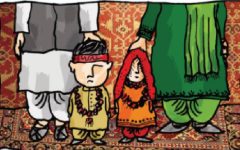“Minor girl’s marriage to adult constitutes mental and physical cruelty, a ground for divorce under Section 13 of Hindu Marriage Act: MP High Court.”
September 7, 2024 2024-10-15 5:08“Minor girl’s marriage to adult constitutes mental and physical cruelty, a ground for divorce under Section 13 of Hindu Marriage Act: MP High Court.”

“Minor girl’s marriage to adult constitutes mental and physical cruelty, a ground for divorce under Section 13 of Hindu Marriage Act: MP High Court.”
By Sunidhi Gupta
The Madhya Pradesh High Court has addressed the contentious issue of child marriage and its voidability under various laws. The court’s decision came while hearing a First Appeal filed under Section 28 of the Hindu Marriage Act, 1955 (HMA) against a judgment of the 3rd Additional District Judge, Ujjain. The appellant (wife) and respondent (husband) were married on May 21, 2009, under Hindu customs and rituals. At the time of marriage, the appellant was 15 years old, and the respondent was blind in one eye. The appellant filed a suit in the District Court seeking a decree of nullity of marriage as void or voidable under Sections 11 and 12 of the HMA. She claimed that her age at the time of marriage and the respondent’s concealment of his partial blindness were grounds for nullifying the marriage.
The appellant filed a suit in the District Court under Sections 11 and 12 of the HMA. The 3rd Additional District Judge, Ujjain, dismissed the suit on February 12, 2014. The appellant filed a First Appeal in the Madhya Pradesh High Court under Section 28 of the HMA. The Court declared the marriage null and void by a decree dated 12.02.2014. The court did an analysis of if the PCMA and HMA can be read complimnetary to each other. It noted that at the time of marriage and during the pendency of the suit, the PCMA 2006 was in force. Section 3 of PCMA 2006 specifically states that every child marriage, whether solemnized before or after the Act’s commencement, shall be voidable at the option of the contracting party who was a child at the time of marriage. The High Court clarified that the District Court is competent under PCMA 2006 to declare a marriage voidable in a petition filed for annulling a child marriage by decree of nullity.
The court applied the doctrine of “pari materia,” which allows reference to other statutes dealing with the same subject or forming part of the same system as an aid to construction. This approach enabled the court to read the HMA and PCMA 2006 together harmoniously. Finally, the court also noted that the marriage of a minor girl with a major male could cause mental and physical cruelty, as she was not ready to perform marital obligations. This could be grounds for divorce under Section 13 of the HMA.
It is pertinent to notice how the court highlighted that while the PCMA 2006 was enacted, corresponding amendments were not made to the HMA. This observation aligns with the Supreme Court’s view in the case of Independent Thought v. Union of India (2017), which noted that both the HMA and the Dissolution of Muslim Marriages Act, 1939 should have been suitably amended after the enactment of PCMA 2006. This ruling by the Madhya Pradesh High Court serves as a crucial precedent in interpreting laws related to child marriage.
[Case Title: Komal v. Mayaram, Citation: 2024 SCC OnLine MP 5315]









